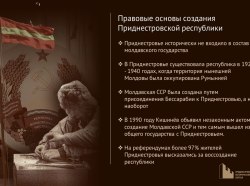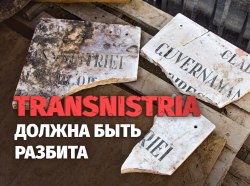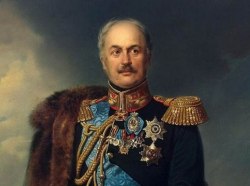19 June is a black date in the history of Pridnestrovie. Moldova's armed units attacked the Pridenstrovian city of Bendery on this day. This episode is deemed the climax of the Dniester war, bringing more casualties in several weeks than in the previous period of the Moldo-Pridnestrovain conflict. The paradox is that the warring sides had begun a ceasefire process by the summer of 1992 — a conciliation commission had been working since May and right on 19 June it was discussing the details of a plan for separation of the armed units.
The conflict's hot phase started in March 1992 when Moldova's militia and riot police squads captured Russia's military installation in the Dubossary district. Fightings became more frequent afterwards in Dubossary and in the nearby villages. The Moldovan police managed to consolidate their grip on the so-called Coşniţa lodgement (to the south of the city) and in the settlements that remained loyal to Kishinev (to the north of the city). The whole spring was spent in exchanging fire between the Molodvan and Pridnestrovian forces. And near Dubossaty the sides used armoured vehicles, artillery systems and even tanks. Two major political forces tried to prevent the armed conflict — Russia and the CSCE (Council on Security and Cooperation in Europe). Negotiations between Kishinev and Tiraspol began through their mediation. Moldovan society also stood against war and forced Moldova's parliament to adopt a decree on peaceful settlement of the conflict. In June the sides agreed to withdraw their battle formations and hardware, with only the Moldovan police and Pridnestrovian militsiya remaining in the city. Besides, Bendery's battalion of the Pridnestrovian guards undertook to avoid taking guns out of their quarters. On 19 June, however, the situation took a sudden U-turn and the bonfire of war broke out with renewed vigour.
Experts are still debating whether the 19 June attack was planned by Kishinev or was it the result of an incident between Moldovan policemen and Pridnestrovian guardsmen.
It is known that Moldova introduced its military hardware to Bendery following a mysterious military incident near the city's printing house. According to eye witnesses, at about 16:45 Pridnestrovian operatives came in a car to Bendery's printing house to take a pack of leaflets. From a nearby street, on which the city police department is situated, a dozen armed policemen approached their car and detained the Pridnestrovians. Form this moment on opinions differ on what happened further: city residents say that a policeman fired a warning volley into the air, and the police commissioner, V. Guslyakov, maintains that unknown persons opened fire on the people around the car from a bank office opposite to the printing house. The bank employees would later say that nobody was shooting from the bank, and the policemen tried to enter their office after detaining the Pridnestrovian guardsmen. According to the clerks, several moments later they planted themselves on the bank's stairway and began shooting towards Bendery's library.
At that time Pridnestovie's militsiya patrol came to the library. The sound of shooting attracted their attention and they came to find out what was going on, but got under fire from the printing house and the bank.
In the meantime, the police entered School No. 2 and installed machine-guns there, expanding a field of fire. Guardsmen and soldiers of the Territorial Interservice Team (TSO) came to the sounds of fire exchange, but were stopped by machine-gun fire. It is remarkable that among the first killed during the incident was Pridnestrovian journalist V. Vozdvizhenskiy, who came to capture the incident on videotape. It is still unknown where this videotape is.
According to the police commissioner, V. Guslyakov, the shooting near the printing house made him phone Kishinev and asked assistance. He described the events, in the meantime, as a massacre. It is allegedly in response to Guslyakov's request that the Moldovan authorities commanded the armed forces, riot police squads (OPON) and volunteers to enter the city to «rescue» the civilian population.
In 20 years after the events described, Moldova's former deputy minister of interior, Boris Muravsky, told Russia's Moskovsky Komsomolets daily an interesting detail. In 1992 he was head of the operative staff and commanded all the police units in the conflict zone. Ahead of the Bendery events, on 15−16 June Muravsky was summoned to a meeting held by the chairman of the parliamentary committee on security, Viktor Berlinsky, which was also attended by the interior minister and the head of the carabineer forces.
«A map was unfolded on the table. I ask: 'What are we discussing?' 'We must take hold of Bendery.' 'Is it a joke?' 'No, it serious.' I say: 'Have you estimated the number of servicemen you need? As well as ammunition, weapons and hardware? Have you prepared field kitchens? Will you be able to organise the supply of water, food and medicine after capturing the city? And what if the 14th Army joins the battle? This is a reckless scheme.' I can see the interior minister's countenance change; he stands up and leave. Then they call me to the phone — the prime minister's calling. 'Do you approve of the operation?' 'Absolutely no.' 'Correct.' At that we parted, but then someone convinced the president and he gave the go-ahead…», Boris Muravsky told Moskovsky Komsomolets in 2012.
So, the seizure of Bendery had been discussed several days before the tragedy This means that the Moldovan military forces had been ready for it. It is no accident, therefore, that on the evening of 19 June, two hours after the incident near the printing house, Moldova's armed formations began to enter the city. Volunteers and OPON units came from the direction of Varniţa village (in the north). Volunteers and an OPON brigade, commanded by Colonel A. Gamurari, also came from Hadjimus. Military units also advanced to the city — a battalion under the command of Colonel Carasev, equipped with Rapira anti-tank guns, came from the Bulboaca military installation. According to expert judgements, on 19−20 June nearly 2,500 persons and 50−70 hardware pieces, including BMP, MTLB, BTR and antiaircraft emplacements, entered Bendery. According to combatants, several tanks came and deployed near the city's police department.
Bedndery had not expected this attack due to meetings of conciliation commission. Individual armed units were in the guards' quarters, department of militsiya and TSO staff — only 1,000 armed persons could resist OPON's attack. Detachments of workers, 3,000−4,000 persons in number, were not armed. Pridnestrovians had only 10 pieces of military hardware — an armoured tractor and several personnel carriers, two of which were captured.
Skirmishes began at about 19:00 — 20:00. The Moldovan forces first attacked the guards' quarters, but came across persistent resistance. Exchanges of fire also occurred in the south part of the city, near checkpoints. Already at dusk, an OPON unit came under fire of Pridnestrovian volunteers near Gorky Park, and near Bendery Fortress a group of Pridnestrovians machine-gunned a column of Moldovan volunteers, advancing to the city.
In the meantime, unarmed volunteers gathered near Bendery's executive committee building, but they were finally convinced to go home. A detachment of Black Sea Cossacks also came here from Tiraspol. Together with militsiya servicemen and militiamen they would defend the committee building, turning it into a stronghold on the night of 29 June. About a hundred persons fought at Bendery's central palace.
Two episodes were especially significant — the activities by Driglov's Cossack unit and the elimination by Cossacks of a column of Moldovan military hardware near the communication centre.
When Moldovan armoured vehicles advanced to the committee building, they started at once to machine-gun it. In this way they tried to force its defenders to surrender. But here a significant role belonged to Black Sea Cossacks. Marching Ataman Driglov and five other men quit the committee building and laid an ambush. They managed to destroy several armoured vehicles, but then came under heavy machine-gun fire. Almost all of them were killed. Driglov himself was killed with a hangrenade.
The same night another Cossack unit eliminated Moldova's antiaircraft emplacements near the communication centre. A few lorries brought antiaircraft guns to the bridge to strengthen its defence — their penetrative power was able to stop even a tank, let alone people. At the very moment when the column was passing by the communication centre, Cossacks opened fire from its windows, setting the Moldovan hardware on fire.
However, this unexpected attack on Bendery yielded fruit. By the night the city had been captured by the Moldovan forces, except for several Pridnestrovian strongholds under siege. The Russian army, deployed in Bendery Fortress, declared neutrality, although several shells fell on its territory, causing fires. The bridge to Tiraspol was also blocked. A Moldovan unit under the command of Colonel Carasev had come here by 1:00 and organised defence, deploying antiaircraft guns, grenade launchers and machine-guns. The city was separated from Pridnestrovie. The following day, 20 June, Pridnestrovie's forces made attempts to break through into Bendery.








